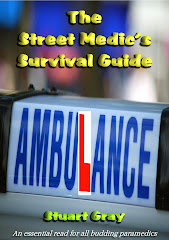Day shift: Six calls; three by car; three by ambulance.
Stats: 1 Broken nose; 1 eTOH fit; 1 Gas inhalation; 1 Back pain; 1 Flu; 1 Fractured wrist and ? Neck.
On this mild November morning, a 25 year-old woman tripped over an uneven kerb and fell flat on her face, breaking her nose and bleeding all over the pavement. She sat alone, crying and leaking from her nostrils until an off-duty police officer saw her and stopped to help. I think she was on her own for ten or twenty minutes.
I have my Student Paramedic (SP) on duty with me all weekend, so she attended as I watched. There was nothing we could do for the young woman except take her to hospital in the car as she sobbed into her phone, explaining to her friend what had happened. Her bleeding was under control but her nerves weren’t settled yet.
Alcoholics are prone to seizures and sometimes it’s obvious what’s happened to someone when you see their pallid, profusely sweating faces. Add a history of falling over suddenly and evidence of possible alcoholism in the form of a half bottle of vodka in their pocket and it’s a no-brainer.
This 30 year-old alcoholic had fallen over in seizure, smashing the back of his head on the glass part of the front door of a coffee shop. There was a large crack where his head had made contact. His fit had lasted a few seconds and he’d bitten his lip but he was over the worst and recovering in the company of two police officers when we arrived.
I wasn’t sure of the man’s honesty when he assured us that he’d behave in the car if we took him to hospital that way, instead of by ambulance because he was reluctant to go to either of the two hospitals that I serve. He must be getting thrown out of them and there’d be a good reason for that, so I asked the cops to do a background check on him and, sure enough he had a history of violence and other problematic things (like suicidal tendencies). He was calm and reasonable though, so the cops agreed to follow me down to the hospital if I took him in the car. I’m still not happy to make an ambulance crew convey a patient who could quite easily be taken in the back of the FRU, so that was that and the trip was uneventful.
After coffee and one of those messy but delicious chocolate swirl thingies, we were off to an 82 year-old man with a history of black outs who’d collapsed at home and triggered his Careline alarm. Another FRU was on scene and we all travelled the lift to the floor on which the elderly gentleman lived. The SP and the other FRU paramedic went into the flat and I followed a few seconds behind them. They were assisting the patient as he lay on the floor of his room but I immediately smelled gas and asked if the others did too. He had left his cooker ring on and for at least 20 minutes, gas had been escaping into the little flat. He also had heaters on and this meant the hazard was higher for all of us.
We evacuated him and I took the keys from the door and allowed it to close. A window had been left open to air the flat out but we asked for the LFB anyway, just in case because I suspected that an electrical heater was running in one of the rooms.
The FRU paramedic’s equipment was inside the flat when I closed the door and I was distracted by the fact that the patient collapsed and became unconscious on the landing just as the crew arrived to help. He recovered quickly on oxygen but I found that when the door had closed it locked on the Yale. The keys I had taken were the wrong ones and didn’t fit, so now all the equipment was locked inside. I’d taken quite a lungful of the gas and, although it shouldn’t do me any harm, it still made me feel dizzy for a while. So we were on the landing with a collapsing patient (his ECG showed a heart block), a paramedic’s gear locked behind a door and the prospect of something igniting the gas inside the flat.
The police showed up just before the Fire Brigade arrived and I went downstairs with the patient and crew to the ambulance. He was stable now but his breathing wasn’t great and there was an obvious retraction of his intercostals and diaphragm, so he was blued in.
The LFB made the flat safe before we left for hospital and the fuss died down around the building (residents were beginning to worry). My head cleared and we got on with it.
An unnecessary ambulance trip next for a 40 year-old man with a childish estimation of his age: ‘How old are you?’ ‘I’m 40 and a half’. He was lying face down on the floor of a police station where he’d presented himself after travelling from deepest south London. His only business with the police was to inform them that he had a sore back.
He had been drinking (a half bottle of vodka by his own admission) and his hands bore the tell-tale swollen knuckles that indicated a puncher (of things or of people), so I was wary of him. He moved into a sitting position after much persuasion and the crew took him, reluctantly on his feet and slowly, to the ambulance, where he became cured by distraction, as often happens with people who are drunk and have nothing else wrong with them. He would now tie up a hospital bed or waiting room chair until he is sober.
Oxford Street was pedestrian-busy as we weaved around the buses to get to our next port of call. Inside the large store, a 30 year-old member of staff lay on the floor of the Manager’s office, refusing to open her teary eyes and playing limp as if dying. I’ve seen this many, many times before and you know I just hate it when adults behave like that; with some certainty I can tell immediately that there is little wrong with them – not enough to warrant an emergency ambulance, that’s for sure.
The SP managed to get the patient to speak but of course, in time-honoured fashion for this behaviour, all verbal responses were whispered. Little voice patients believe that making inaudible sounds with their vocal chords is tantamount to establishing serious illness for the benefit of colleagues and anyone else near enough to actually hear them.
She had aches and pains (pain all over), a cough, dizziness and vomiting – she probably had ‘Flu and since all influenza these days is H1N1 Piggy-type, she was given a mask and we donned our own. The drama was too much for the staff and we found ourselves with some clearance as we made our way out of the place, with the patient in a wheelchair, via the back entrance.
We took her in the car and she ended up waiting, like everyone else with minor problems, suitably masked up, for a doctor to tell her what we already knew – she could go home and get over it naturally.
Finally, as darkness invaded the day and the rain spoiled everyone’s fun, we were sent to the 5th floor of a large store where a 30 year-old staff member had slipped on water and landed awkwardly on the hard toilet floor near the urinals he’d just visited. He was complaining of pain in his right wrist, which was probably broken at the Ulna, lower back pain and, more significantly, high spinal pain, at around C2, so he was going to be collared and boarded. Trouble was, there was no ambulance around and I had to call for one.
During the wait for the ambulance I gave the man morphine for his wrist pain (he couldn’t tolerate entonox) but his respirations suddenly dropped and he tried to go to sleep. I’d only given him a smallish amount but I was forced to reverse it all by giving him Narcan in small doses until he came back to normal (or as normal as possible).
Now that he was stable and feeling the same pain as he had originally, thanks to the lack of analgesia (next time I will give Oromorph), the crew arrived and together we got him onto a stretcher and took him down in the freight elevator (the only one big enough for the stretcher and all of us) to the ambulance.
This was blued in once I was sure his breathing was better and his trip to hospital lasted five minutes. The entire job, from start to finish, took almost 2 hours. And I got home late. Never mind.
Be safe.
Subscribe to:
Post Comments (Atom)















4 comments:
Hi there
How much morphine IV did you give him? You said a small(ish) amount, which makes me guess 5mg? ;-)
He must have been in quite a lot of pain so - considering he tolerates neither Entonox nor Morphine - what do you think did they give him in hospital?
I wouldn't give him any opiates since he is likely to have another hypersensitivity reaction, what do you think?
In my country we don't give Morphine anyway so he would end up with a mix of Ketamine and Midazolam (Dormicum) or Metamizol 1g IV (depending on the pain score).
Really love your blog, keep up the good work ;-)
Claire
Claire
Yep, 5mg. I'm not sure how they would have progressed his analgesia once in hospital but I'm guessing they'd look at a similar option to that described in your comment.
Rumour has it that ketamine will be added to the list of drugs available to paramedics, that would certainly give you another option. Paramedics working for Essex police are already issued it. No idea how long it would take to roll out though.
JB102
Yes, Ive heard this and I think we are waiting for our Medical Advisor to make a decision.
Post a Comment